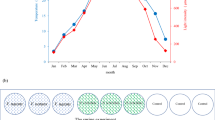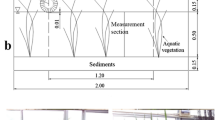Abstract
Submerged macrophytes and phytoplankton assemblage play significant roles in the functioning of aquatic ecosystems. An experiment was carried out in Beijing in order to further evaluate the environmental factors that affect the growth of submerged macrophytes and phytoplankton assemblage. Submerged macrophytes (i.e., Vallisneria natans, Hydrilla verticillata, and Ceratophyllum demersum) constructed the growth system with some controllable influencing factors (i.e., the flow rate and water depth gradient). The flow rates were set separately as 4 L/h (1#), 6 L/h (2#), and 12 L/h (3#), while the water depth gradient was of 0.5–1.7 m in eutrophic water. Generally, all macrophytes could grow normally in the experiment, and the system could maintain and improve the effluent quality. The average removal rates of NH3-N, COD, NO3-N, TN, and TP were about 90%, 33%, 65%, 45%, and 40%, respectively. Seen from the results of the water depth gradient experiments, it is indicated that Vallisneria natans grows better in shallow water (0.5 m) and moderate shallow water (0.7 m) area, with an average relative growth rate (ARGA) of 57%. Hydrilla verticillata and Ceratophyllum demersum grow better in moderate deep water (1.2 m) and deep water (1.7 m) area (ARGA of 66% and 64%, respectively). Results of the flow rate experiments showed that the moderate flow rate (6 L/h) was the best for those three macrophytes’ growth. As the fitting results of the rapid light curves (RLCs) showed that the utilization of light and the tolerance to strong light were different for these macrophytes, if they are ranked in the order of the utilization and the tolerance from strong to weak, they are Hydrilla verticillata, Ceratophyllum demersum, and Vallisneria natans. Microbial analyses indicated that the overall system diversity of the experimental groups have been improved after cultivation of macrophytes. However, the accumulated Cyanobacteria caused by the low flow rate (1#) would lead to the suppression of microbial organics decomposition and nutrient metabolism in the macrophytes. To sum up, the results of this study provided theoretical guidance and technical support for the restoration of submerged macrophytes in eutrophic water.







Similar content being viewed by others
References
Binzer T, Borum J, Pedersen O (2005) Flow velocity affects internal oxygen conditions in the seagrass Cymodocea nodosa. Aquat Bot 83(3):239–247. https://doi.org/10.1016/j.aquabot.2005.07.001
Choudhury MI, Yang X, Hansson LA (2015) Stream flow velocity alters submerged macrophyte morphology and cascading interactions among associated invertebrate and periphyton assemblages. Aquat Bot 120:333–337. https://doi.org/10.1016/j.aquabot.2014.09.013
Dong B, Qin B, Gao G, Cai X (2014) Submerged macrophyte communities and the controlling factors in large, shallow Lake Taihu (China): sediment distribution and water depth. J Great Lakes Res 40(3):646–655. https://doi.org/10.1016/j.jglr.2014.04.007
Effler SW (1988) Secchi disc transparency and turbidity. J Environ Eng 114(6):1436–1447. https://doi.org/10.1061/(ASCE)0733-9372(1988)114:6(1436)
Gao X, Song J (2005) Phytoplankton distributions and their relationship with the environment in the Changjiang Estuary. China Mar Pollut Bull 50(3):327–335. https://doi.org/10.1016/j.marpolbul.2004.11.004
Gu J, He H, Jin H, Yu J, Jeppesen E, Nairn RW, Li K (2018) Synergistic negative effects of small-sized benthivorous fish and nitrogen loading on the growth of submerged macrophytes–relevance for shallow lake restoration. Sci Total Environ 610:1572–1580. https://doi.org/10.1016/j.scitotenv.2017.06.119
Hempel M, Blume M, Blindow I, Gross EM (2008) Epiphytic bacterial community composition on two common submerged macrophytes in brackish water and freshwater. BMC Microbial 8(1):58. https://doi.org/10.1186/1471-2180-8-58
Hilt S (2006) Allelopathic inhibition of epiphytes by submerged macrophytes. Aquat Bot 85(3):252–256. https://doi.org/10.1016/j.aquabot.2006.05.004
Hutchinson JT (2019) Ex situ phenology of Zizania texana, an endangered aquatic macrophyte, under different water velocities. Aquat Bot 153:88–94. https://doi.org/10.1016/j.aquabot.2018.12.004
Kemppinen J, Niittynen P, Aalto J, le Roux PC, Luoto M (2019) Water as a resource, stress and disturbance shaping tundra vegetation. Oikos 128(6):811–822. https://doi.org/10.1111/oik.05764
Li F, Zhang H, Zhu Y, Xiao Y, Chen L (2013) Effect of flow velocity on phytoplankton biomass and composition in a freshwater lake. Sci Total Environ 447:64–71. https://doi.org/10.1016/j.scitotenv.2012.12.066
Li H, Li Q, Luo X, Fu J, Zhang J (2020) Responses of the submerged macrophyte Vallisneria natans to a water depth gradient. Sci Total Environ 701:134944. https://doi.org/10.1016/j.scitotenv.2019.134944
Lichtenthaler HK, Buschmann C, Knapp M (2005) How to correctly determine the different chlorophyll fluorescence parameters and the chlorophyll fluorescence decrease ratio R Fd of leaves with the PAM fluorometer. Photosynthetica 43(3):379–393. https://doi.org/10.1007/s11099-005-0062-6
Li W, Jiang R, Zhao Y, Xie J, Zhu J, Cao R (2019) Water ecological environment protection under changing environment: a systematic review and bibliometric analysis. J Coast Res 93(sp1):9–15. https://doi.org/10.2112/SI93-002.1
Lv T, He Q, Hong Y, Liu C, Yu D (2019) Effects of water quality adjusted by submerged macrophytes on the richness of the epiphytic algal community. Front Plant Sci 9:1980. https://doi.org/10.3389/fpls.2018.01980
Mackey RL, Currie DJ (2001) The diversity–disturbance relationship: is it generally strong and peaked? Ecology 82(12):3479–3492. https://doi.org/10.1890/0012-9658(2001)082
Madsen TV, Enevoldsen HO, Jørgensen TB (1993) Effects of water velocity on photosynthesis and dark respiration in submerged stream macrophytes. Plant Cell Environ 16(3):317–322. https://doi.org/10.1111/j.1365-3040.1993.tb00875.x
Madsen TV, Sand-Jensen KAJ (1991) Photosynthetic carbon assimilation in aquatic macrophytes. Aquat Bot 41(1-3):5–40. https://doi.org/10.1016/0304-3770(91)90037-6
Margalef R (1967) Some concepts relative to the organization of plankton. Oceanogr Mar Biol Annu Rev 5:257–289
Mitchell SF (1989) Primary production in a shallow eutrophic lake dominated alternately by phytoplankton and by submerged macrophytes. Aquat Bot 33(1-2):101–110. https://doi.org/10.1016/0304-3770(89)90023-5
Nurminen LK, Horppila JA (2002) A diurnal study on the distribution of filter feeding zooplankton: effect of emergent macrophytes, pH and lake trophy. Aquat Sci 64(2):198–206. https://doi.org/10.1007/s00027-002-8067-8
Pielou EC (1966a) Shannon’s formula as a measure of specific diversity: its use and misuse. Am Nat 100(914):463–465. https://doi.org/10.1086/282439
Pielou EC (1966b) The measurement of diversity in different types of biological collections. J Theor Biol 13:131–144. https://doi.org/10.1016/0022-5193(66)90013-0
Pielou EC (1969) An introduction to mathematical ecology. Wiley-Inter science, New York, 286 pp
Qiu D, Wu Z, Liu B, Deng J, Fu G, He F (2001) The restoration of aquatic macrophytes for improving water quality in a hypertrophic shallow lake in Hubei Province. China Ecol Eng 18(2):147–156. https://doi.org/10.1016/S0925-8574(01)00074-X
Ralph PJ, Gademann R (2005) Rapid light curves: a powerful tool to assess photosynthetic activity. Aquat Bot 82(3):222–237. https://doi.org/10.1016/j.aquabot.2005.02.006
Richier S, Cottalorda JM, Guillaume MM, Fernandez C, Allemand D, Furla P (2008) Depth-dependant response to light of the reef building coral, Pocillopora verrucosa: implication of oxidative stress. J Exp Mar Biol Ecol 357(1):48–56. https://doi.org/10.1016/j.jembe.2007.12.026
Rojo C, Segura M, Rodrigo MA (2013) The allelopathic capacity of submerged macrophytes shapes the microalgal assemblages from a recently restored coastal wetland. Ecol Eng 58:149–155. https://doi.org/10.1016/j.ecoleng.2013.06.019
Rovira A, Alcaraz C, Trobajo R (2016) Effects of plant architecture and water velocity on sediment retention by submerged macrophytes. Freshw Biol 61(5):758–768. https://doi.org/10.1111/fwb.12746
SC/T9402-2010 (2011) The specifications for freshwater plankton surveys. China Agriculture Press, Beijing, China (in Chinese)
Shannon CE, Weaver W (1949) The mathematical theory of communication. University of Illinois Press, Urbana, IL, 117 pp
Simpson EH (1949) Measurement of species diversity. Nature 163:688
Terada R, Vo TD, Nishihara GN, Shioya K, Shimada S, Kawaguchi S (2016) The effect of irradiance and temperature on the photosynthesis and growth of a cultivated red alga Kappaphycus alvarezii (Solieriaceae) from Vietnam, based on in situ and in vitro measurements. J Appl Phycol 28(1):457–467. https://doi.org/10.1007/s10811-015-0557-x
Vačkář D, ten Brink B, Loh J, Baillie JE, Reyers B (2012) Review of multispecies indices for monitoring human impacts on biodiversity. Ecol Indic 17:58–67. https://doi.org/10.1016/j.ecolind.2011.04.024
Van Donk E, van de Bund WJ (2002) Impact of submerged macrophytes including charophytes on phyto- and zooplankton communities: allelopathy versus other mechanisms. Aquat Bot 72(3-4):261–274. https://doi.org/10.1016/S0304-3770(01)00205-4
van Nes EH, Scheffer M, van den Berg MS, Coops H (2003) Charisma: a spatial explicit simulation model of submerged macrophytes. Ecol Model 159(2-3):103–116. https://doi.org/10.1016/S0304-3800(02)00275-2
Wang H, Zhong H, Bo G (2018) Existing forms and changes of nitrogen inside of horizontal subsurface constructed wetlands. Environ Sci Pollut R 25(1):771–781. https://doi.org/10.1007/s11356-017-0477-1
Wang J, Zhang Z, Johnson B (2019a) Low flows and downstream decline in phytoplankton contribute to impaired water quality in the lower Minnesota River. Water Res 161:262–273. https://doi.org/10.1016/j.watres.2019.05.090
Wang P, Zhang Q, Xu YS, Yu FH (2016) Effects of water level fluctuation on the growth of submerged macrophyte communities. Flora 223:83–89. https://doi.org/10.1016/j.flora.2016.05.005
Wang Q, Li S, Li R (2019b) Evaluating water resource sustainability in Beijing, China: combining PSR model and matter-element extension method. J Clean Prod 206:171–179. https://doi.org/10.1016/j.jclepro.2018.09.057
Wei H, He F, Xu D, Zhou Q, Xiao E, Zhang L, Wu Z (2018) A comparison of the growth and photosynthetic response of Vallisneria natans (Lour.) Hara to a long-term water depth gradient under flowing and static water. J. Freshwater Ecol 33(1):223–237. https://doi.org/10.1080/02705060.2018.1432509
Xiao K, Yu D, Wu Z (2007) Differential effects of water depth and sediment type on clonal growth of the submersed macrophyte Vallisneria natans. Hydrobiologia 589(1):265–272. https://doi.org/10.1007/s10750-007-0740-4
Yang W, Zheng Z, Zheng C, Lu K, Ding D, Zhu J (2018) Temporal variations in a phytoplankton community in a subtropical reservoir: an interplay of extrinsic and intrinsic community effects. Sci Total Environ 612:720–727. https://doi.org/10.1016/j.scitotenv.2017.08.044
Yang Y, Yi Y, Wang W, Zhou Y, Yang Z (2020) Generalized additive models for biomass simulation of submerged macrophytes in a shallow lake. Sci Total Environ 711:135108. https://doi.org/10.1016/j.scitotenv.2019.135108
Zeng XT, Hu ZJ, Zhang J, Fu YC, Kong XM, Chen C, Huang G, H., & Zhang, F. (2019) Toward a sustainable water resources management in Beijing-Tianjin-Hebei urban agglomeration: a scenario analysis of combined strategy regulation with Green Z-score criterion. Urban Water J 16(8):537–553. https://doi.org/10.1080/1573062X.2019.1687740
Zhang H, Zhao Y, Yin H, Wang Y, Li H, Wang Z, Geng Y, Liang W, Wang H (2019a) Effect of aquatic macrophyte growth on landscape water quality improvement. Environ Sci Pollut R 26(33):33791–33803. https://doi.org/10.1007/s11356-018-2421-4
Zhang L, Li K, Liu Z, Middelburgd JJ (2010) Sedimented cyanobacterial detritus as a source of nutrient for submerged macrophytes (Vallisneria spiralis and Elodea nuttallii): an isotope labeling experiment using 15 N. Limnol Oceanogr 55(5):1912–1917. https://doi.org/10.4319/lo.2010.55.5.1912
Zhang Q, Liu YP, Luo FL, Dong BC, Yu FH (2019b) Does species richness affect the growth and water quality of submerged macrophyte assemblages? Aquat Bot 153:51–57. https://doi.org/10.1016/j.aquabot.2018.11.006
Zhang X, Qin H, Wang H, Wan A, Liu G (2018) Effects of water level fluctuations on root architectural and morphological traits of plants in lakeshore areas of three subtropical floodplain lakes in China. Environ Sci Pollut R 25(34):34583–34594. https://doi.org/10.1007/s11356-018-3429-5
Zhu J, Liu B, Wang J, Gao Y, Wu Z (2010) Study on the mechanism of allelopathic influence on cyanobacteria and chlorophytes by submerged macrophyte (Myriophyllum spicatum) and its secretion. Aquat Bot 98(2):196–203. https://doi.org/10.1016/j.aquatox.2010.02.011
Acknowledgments
We greatly appreciate the critical and constructive comments from the anonymous reviewers, which have helped improve this manuscript.
Funding
The authors would like to express their thanks to the financial support from the National Key Research and Development Program of China (No. 2016YFC0401405), Major Science and Technology Program for Water Pollution Control and Treatment of China (2017ZX07103-004), and Major Foundation of Hebei Educational Committee (No. ZD2019067).
Author information
Authors and Affiliations
Corresponding authors
Additional information
Responsible Editor: Philipp Gariguess
Publisher’s note
Springer Nature remains neutral with regard to jurisdictional claims in published maps and institutional affiliations.
Electronic supplementary material
ESM 1
(DOCX 491 kb)
Rights and permissions
About this article
Cite this article
Xu, D., Xia, Y., Li, Z. et al. The influence of flow rates and water depth gradients on the growth process of submerged macrophytes and the biomass composition of the phytoplankton assemblage in eutrophic water: an analysis based on submerged macrophytes photosynthesis parameters. Environ Sci Pollut Res 27, 31477–31488 (2020). https://doi.org/10.1007/s11356-020-09404-w
Received:
Accepted:
Published:
Issue Date:
DOI: https://doi.org/10.1007/s11356-020-09404-w




